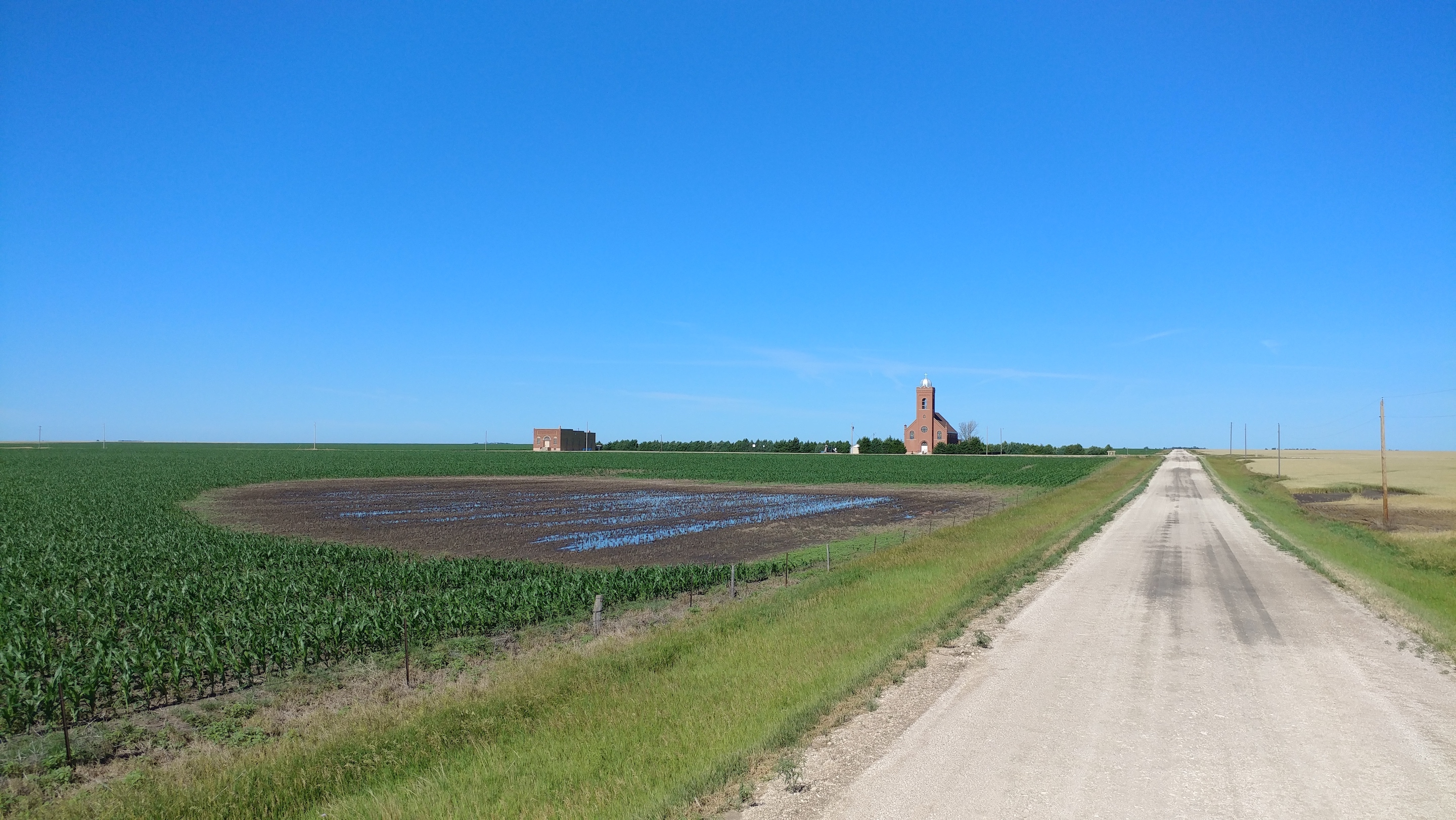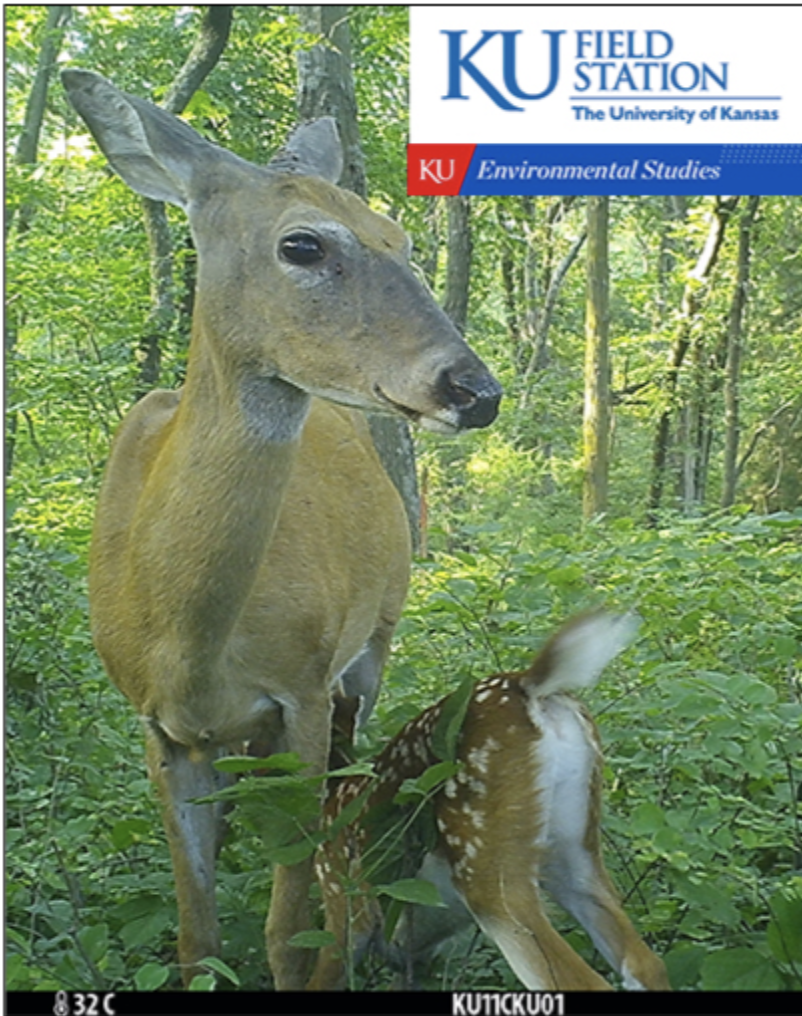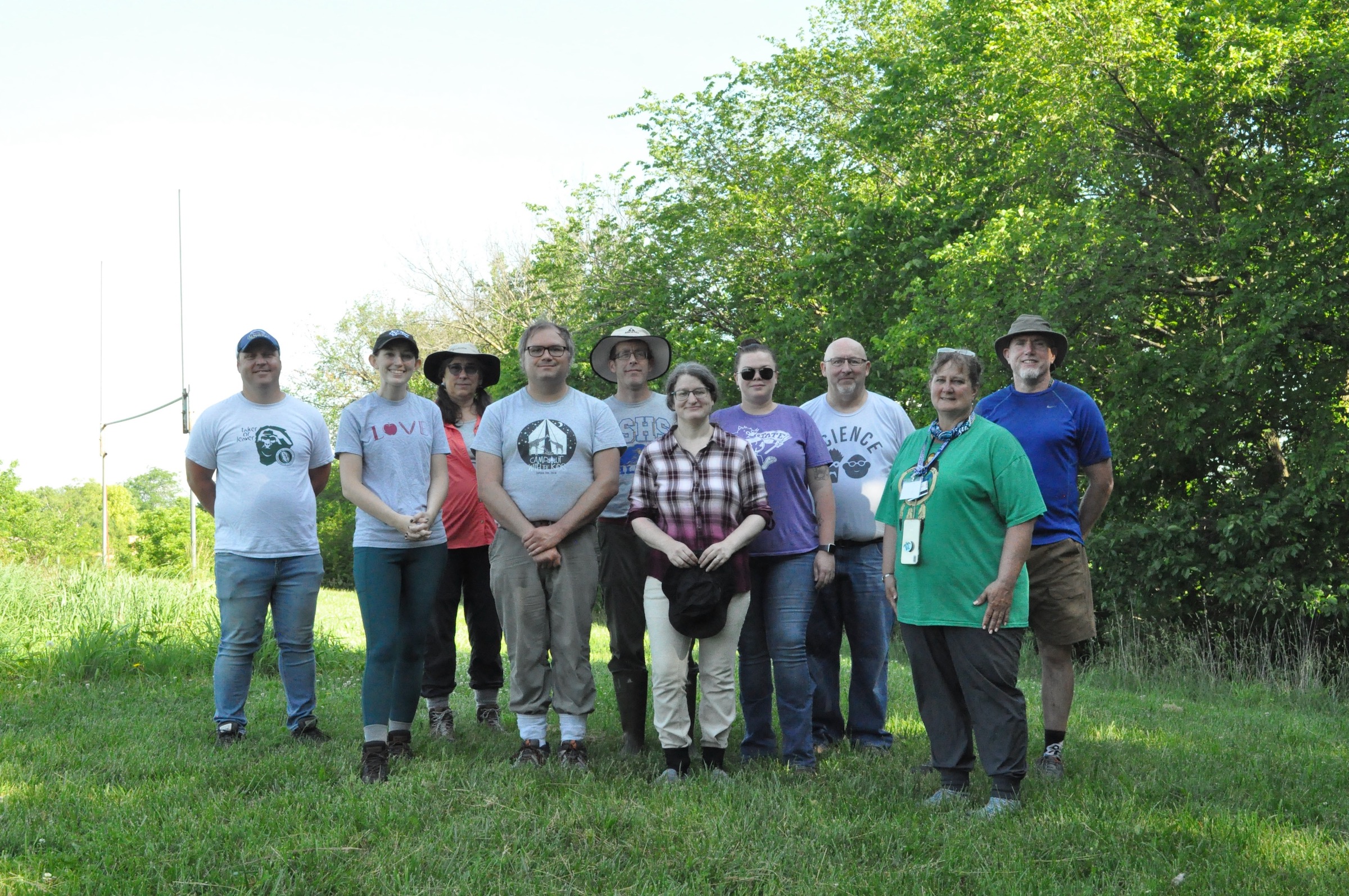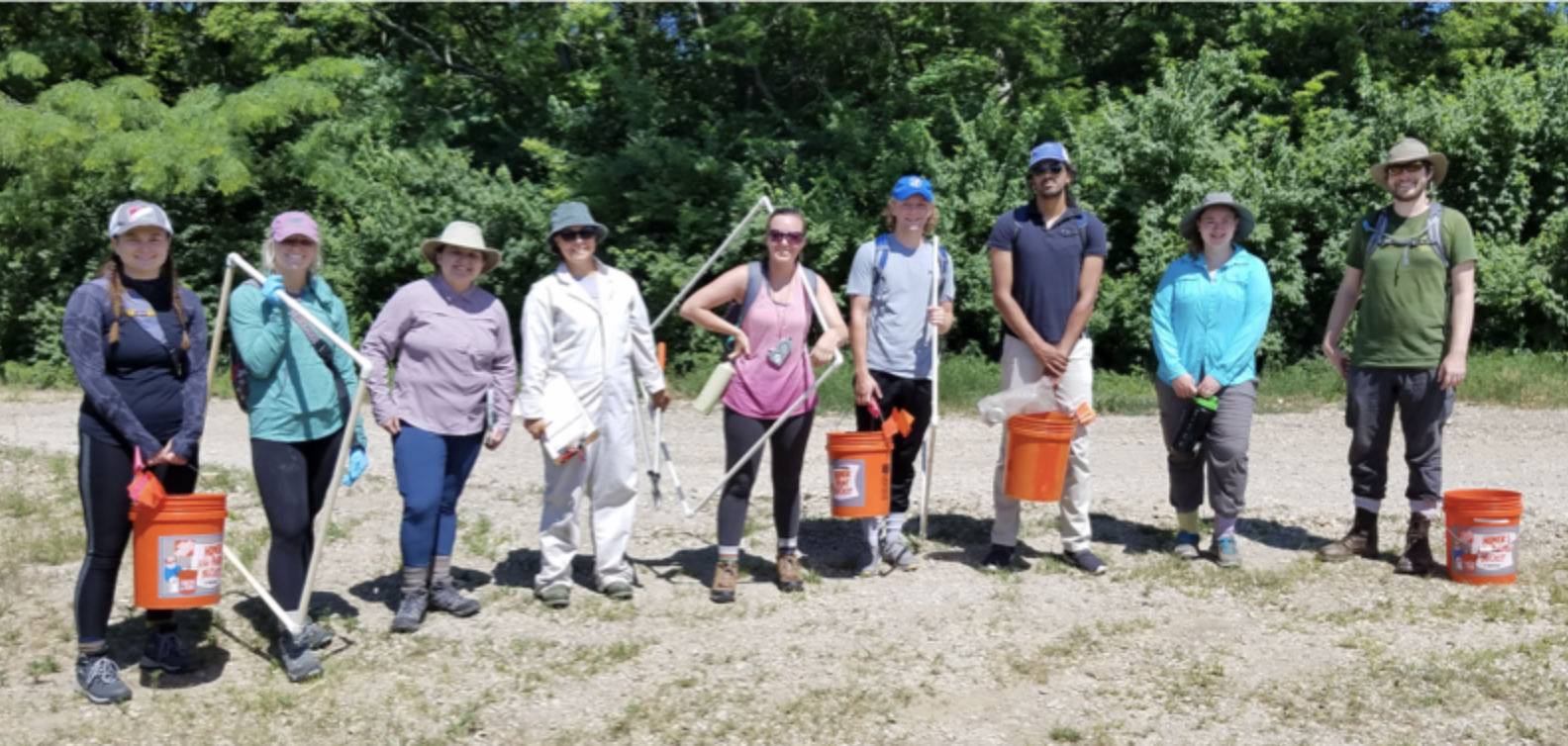Understanding Our Environment

July 2021 Issue
Understanding Our Environment is the internal newsletter for the Kansas Biological Survey & Center for Ecological Research community. Please email biosurvey@ku.edu regarding any errors or omissions.
Photo: After a long month of rain and high winds in May, the Bever/Schultz Lab was finally able to install films onto rainout shelters at the Dimensions site at the KU Field Station in early June. Lab members, KU Field Station crew and greenhouse installation professionals got all 12 shelters covered in one day. Left to right: Haley Burrill, Audrey Nelson, Megan Hamersky, Claire Blanck, Eleanor Matheis and Dori Summers. Photo by Aaron Baumgardner, Bever/Schultz Lab research technician.
Comings and Goings
We welcome Zachary Brecheisen, postdoctoral researcher in the Billings Lab. He has a Ph.D. in ecosystem ecology from Duke University and has since held a postdoc at Purdue University. He has experience working with below-ground soil gas dynamics as they relate to ecosystem carbon and water fluxes. In the Billings Lab, he will be working on understanding how topography and climate interact to influence ecosystem productivity. Sharon Billings is a Bio Survey senior scientist and Dean’s Professor of Ecology and Evolutionary Biology (EEB).
Nathaniel Coombs, doctoral student in EEB,has joined the Reuman Lab as a GRA. He will begin studying synchrony in giant kelp communities and theoretical aspects of understanding influences of climate change on synchrony. Dan Reuman is a Bio Survey senior scientist and a professor of EEB.
Several new members of Jim Thorp’s Aquatic Ecology Lab have arrived: Elizabeth Brock, a student at Haskell Indian Nations University, will be with the lab for at least the summer and may continue for a year if a National Science Foundation REU (Research Experiences for Undergraduates) grant is awarded; Eric Faqua, a 2021 KU graduate, will be with the lab for the summer and may become a full-time participant if an NSF REPS (Research Experience for Post-Baccalaureate Students) grant is awarded; and Andrew Karlin has joined the lab as a master’s-level research technician to work full-time on the lab’s current wetlands study. In July, Mica Rumbach, lab technician, will depart for graduate school in Ohio. Jim Thorp is a senior scientist at the Bio Survey and a professor of EEB.
Milestones
Each year, KU Human Resources lists employees to be recognized for State of Kansas service. This spring, HR distributed a list for 2020:
David Weekley (KARS) — 5
Chris Bishop (KARS) — 10
Kirsten Bosnak (Communications) — 10
Christopher Rogers (Rogers Lab) — 10
Brandy Hildreth Baranski (Admin) — 15
Debbie Baker (CPCB) — 20
Mike Houts (KARS) — 20
Jude Kastens (KARS) — 20
Dana Peterson (KARS) — 20
In addition, Christopher Rogers has been promoted to associate research professor.
Grants
Mike Houts, Bio Survey associate researcher, received notification that two of his grant proposals had been approved. Both begin July 1. The first is a one-year grant from the Douglas County Heritage Conservation Council to improve monarch butterfly and pollinator habitat on 10 acres of land operated as part of the Mutt Run off-leash dog park near Clinton reservoir. The project will implement measures to increase the abundance and diversity of native grasses and pollinator-friendly forbs. Jennifer Delisleis co-PI, and Monarch Watch is assisting by providing some plants. The second grant, funded by the Information Network of Kansas (INK) is for a two-year project to develop the nested hexagon framework as an annotated spatial data index for Kansas datasets. These will be summarized and indexed into the grid, making the summarized information readily available and the datasets more discoverable.
Jude Kastens is co-PI on a $270,000 grant from the U.S. EPA through the Kansas Water Office for a two-year study of the interaction between playas — depressions that create temporary wetlands — and agriculture. The goal of the study is to improve understanding of how farming playas affects the rate of aquifer recharge and associated issues. Tony Layzell of the Kansas Geological Survey is PI. Jude heads the portion of the study looking at the economics of farming through playas vs. farming around them. Debbie Baker and Jennifer Delisle already have been working on ecological assessment of 15 study sites in west-central Kansas. KU News published a story on the project.

Publications
Chip Taylor, professor emeritus and Monarch Watch director, is co-author on a paper in the journal Conservation Science and Practice (of the Society for Conservation Biology): “Are eastern and western monarch butterflies distinct populations? A review of evidence for ecological, phenotypic, and genetic differentiation and implications for conservation.” From the abstract: “Eastern and western monarchs occupy distinct environments and show some evidence for phenotypic differentiation, particularly for migration-associated traits, though population genetic and genomic studies suggest that they are indistinguishable from one another. We suggest future studies that could improve our understanding of differences between eastern and western monarchs. We also discuss the concept of adaptive capacity in eastern and western monarchs as well as non-migratory populations outside of the monarch’s primary North American range. Finally, we discuss the prospect of completely losing monarchs from western North America and what this entails for monarch conservation.”
Terra Lubin, Peggy Schultz, Helen Alexander and Jim Bever, along with high school teacher Pam Lucas, have published a study, “Evidence of adaptation of Little Bluestem to the local environment of central Kansas,” in the Transactions of the Kansas Academy of Science. The study was done in collaboration with high school teachers and students from across Kansas and emerged from the Ecosystems of Kansas Summer Institute developed and overseen by Peggy. The Institute is part of the $20M NSF EPSCoR MAPS (Microbiomes of Aquatic, Plant, and Soil Systems across Kansas) Track-1 grant announced in 2017. Pam Lucas, science teacher at Skyline High School in Pratt, Kansas, attended the Institute in 2018 and returned for the 2020 Institute in early June (see item on the 2020 Institute below) to present her subsequent work to 2020 participants. Terra is a postdoc in the Bever/Schultz Lab; Peggy is a Bio Survey researcher and faculty member in the Environmental Studies Program; Helen is a professor of EEB (retiring); Jim is a Bio Survey senior scientist and Foundation Distinguished Professor of EEB.
Christopher Rogers, associate research professor, has published, in the journal Zootaxa, the first of a two-part series revising the spiny clam shrimp family Leptestheriidae for southern Africa: “Review of the southern African Leptestheriidae (Branchiopoda: Spinicaudata) I: redescription of Leptestheria brevirostris Barnard, 1924 with comments on diagnostic characters.” The paper presents the first records of Leptestheria brevirostris since its discovery in Namibia in 1924. The authors’ records come from Botswana and South Africa and present significant range extensions, as well as detailed descriptions.
Kayla Clouse, doctoral student in the lab of Maggie Wagner, has published her first paper “Plant Genetics as a Tool for Manipulating Crop Microbiomes: Opportunities and Challenges,” in the journal Frontiers in Bioengineering and Biotechnology. The paper explores manipulation of the host genome as an approach to manipulating crop microbiomes in the area of increased but sustainable food production. Maggie is a Bio Survey assistant scientist and assistant professor of EEB.
A new article in the journal Ecology describes findings from Snapshot USA, the first-ever nationwide mammal study, including discoveries made with the help of KU undergraduates working with Bob Hagen at the KU Field Station. The study involved more than 150 scientists working in all 50 states and collecting data from more than 1,500 motion-activated camera traps. Bob is the field education and internship coordinator for the Environmental Studies Program and a longtime affiliate of the Bio Survey through his work at the Field Station. He presented results from the camera traps at a Friday Ecology Seminar via Zoom in March.

Awards
Camille Delavaux, doctoral student the Bever/Schultz Lab who graduated in March of this year, was awarded the Argersinger Dissertation Award, which is given for the best dissertation in science, technology, engineering and mathematics, and the best dissertation in social science, education, humanities and the arts. Camille’s dissertation is titled “Biogeographic plant-microbe patterns and process: natural and anthropogenic impacts across three spatial scales.” She is now a postdoctoral researcher at ETH Zürich in the Dept. of Environmental Systems Science. (Rachel Bowes of the Thorp Lab received the Argersinger Award in 2017.)
Ceyda Kural, doctoral student in the lab of Maggie Wagner, has won a Richard H. Himes Graduate Teaching Award for her work as a GTA in Ben Sikes’s Biology of Fungi class during the spring 2021 semester. Ben is a Bio Survey associate scientist and associate professor of EEB.
Amy Burgin, Bio Survey associate scientist and associate professor of EEB, has been selected for a KU Keeler Family Intra-University Professorship for spring 2022. This faculty development program for tenured faculty at mid-career provides one semester free of departmental responsibilities for interaction with faculty members in another discipline to result in development or expansion of ongoing interdisciplinary research and teaching collaboration. Amy plans to develop ideas around water research and training.
Outreach
The University of Kansas has been selected as the 2022 host for the Midwest Ecology and Evolution Conference (MEEC), an annual regional conference hosted by different Midwestern institutions each year and organized and directed entirely by graduate students. Previous conferences have drawn 250 to 300 attendees. KU was chosen as host thanks to the efforts of graduate students Ashley Wojciechowski (Baer Lab), Haley Burrill (Bever/Schultz Lab), Reb Bryant (Bever/Schultz Lab), Nathaniel Weickert (Baer Lab), Katie Eckhoff (Baer Lab), Nikki Dyanne Castanos Realubit (Biodiversity Institute) and Rachel Neff (Biodiversity Institute). More information is forthcoming.
The third Ecosystems of Kansas Summer Institute, a program developed and overseen by Peggy Schultz, was held June 7-11 at the KU Field Station and nearby sites. The Institute, an outreach component of the NSF EPSCoR MAPS grant, brought together 10 high school science teachers from across Kansas to work with KU scientists to learn about current research and methods that link to K-12 science standards. The five-year annual program was not held in 2020, but NSF will allow the Institute to be held an additional year. 
Jennifer Moody, assistant researcher senior, shares updates on happenings at the Native Medicinal Plant Garden, the Field Station site closest to campus:
• Visitors continue to come to the garden and fill out the guest registry (photo below shows a sample);
• A group of volunteers through the Douglas County Extension Master Gardeners is working at the garden this summer, along with two student interns; the Master Gardeners have been working on establishing a small prairie patch the past two years;
• The KU Community Garden is growing food at the site again this year to donate to local food banks, and the KU Bee Club is active with new beehives;
• The garden will be part of KU Hawk Week, in late August, with a tour for incoming first-year students in conjunction with the KU Common Book, Braiding Sweetgrass, by Robin Wall Kimmerer; in anticipation of this event, more than 20 sweetgrass plants have been planted;
• Gardeners also have been working with Mary Anne Jordan, a textiles professor in the KU Dept. of Visual Art, to plant and dye fiber plants; her students collected material at the garden last year, and there are plans to do so again in the future.
In the Field
Katie Eckhoff and Nathaniel Weickert, graduate students in the Baer Lab (Sara Baer, Bio Survey director), assisted with Bob Hagen’s summer Field Ecology class in late June, providing guidance to undergraduates on fieldwork and restoration topics, and inspiring the class to return for a second fieldwork session to collect more data in grassland and woody sites for better sample sizes. Katie and Nathaniel are at far right in the photo below.
